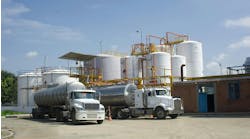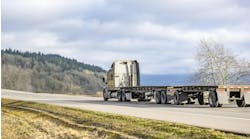In the trucking industry, cost-per-mile (CPM) is always top of mind as it impacts every aspect of a trucking operation. The lower the cost, the more competitive you are, and the more profitable you can be.
Driver training, and the safety of a fleet, plays a big role in driving down CPM. To showcase that, we at CarriersEdge did a deep dive to uncover how online training—as a complement to traditional training—impacts a fleet’s CPM. And we looked at the return on investment for those offering online training.
The status quo and determining ROI
First, training can’t change a person’s behavior or fix problems unrelated to knowledge. By that, we mean if people know what they’re supposed to do but don’t want to do it, training isn’t the solution.
What training can do is fix knowledge-related problems. It can remind people (and reinforce) what they already know. And it can broaden their knowledge base, helping them see the bigger picture of how safety fits in with their company’s culture.
With that in mind, traditional training—the status quo—encompasses classroom meetings. It starts with orientation and onboarding and progresses to quarterly safety meetings. Often there is one-on-one coaching or training if a driver has issues, such as with securing loads or hard braking. And there are often compliance training costs.
But what are the costs involved? Let’s take a look. The following example gives very conservative numbers but benchmarks costs associated with in-house safety meetings.
“John” is a driver trainer at Acme Trucking, which has 50 drivers on payroll. His salary is $60,000, and he has full benefits. So we’ll need to calculate his benefits along with overhead and other costs (typically, those costs can add 50-125% of the salary). Finding middle ground, we will assume his fully loaded package is $120,000 annually. To calculate John’s daily cost to your company, determine how many workdays there are. Typically, it will be about 240. So for easy math, John’s cost is $500 a day.
Safety meetings
For a quarterly safety meeting—lasting a half-day—John and his staff need to do some prep work and planning. There is also setting up the classroom and time needed to cater a meal. Assume that will take 12 hours. Along with the four-hour presentation, that brings John’s time to two days—or a cost of $1,000 to the company. And you’ll have scheduling disruptions (we figure about 1.5 days’ worth of staff time), so that’s another $750 in hidden costs. Often companies will host the meeting on a Saturday and cater a nice lunch (about $15 a head), so $750 is a light budget for that consideration. Lastly, even though the meeting is mandatory, there are always logistics and other issues to deal with. In our experience, roughly 10% of drivers cannot make meetings. Ironically (or is it?), those who miss meetings often need the most training. Those drivers aren’t off the hook, though.
Most companies will spend time working with those drivers on what they missed. We’ve calculated that to be about 1.5 hours per driver, and in our model of five drivers missing the meeting, it eats up another $500 in company costs. Grand total when all added up? That half-day safety meeting for 50 drivers has cost the company—conservatively—$3,000. With this in mind, you can do the math to estimate the costs associated with onboarding new drivers, which typically takes several days, plus any compliance training drivers may be required to complete (such as annual hazmat renewal). It can be a significant price tag for your comprehensive safety program.
Suppose you were to take that $3,000 half-day safety meeting to see how far it could take you with online training. Turns out it would pay for the cost of a licensing fee for a full year of unlimited training for your team of 60 drivers. That’s an apples-to-apples comparison, but we realize other costs are involved, so let’s explore that.
John still needs to organize the training module he wants the drivers to undergo. But the time requirement is only minimal—we’ve found it to be around 15 minutes or $15 worth of time. Since the training is online, there are no scheduling disruptions, nor are there any non-attendance arrangements. There is often an added cost, though. Many fleets will compensate their drivers for taking test modules, which can vary in price tag. To be conservative, we will say $25 per driver, so a total price tag of $1,250. Combined with your annual online program’s cost ($3,000), you’ve now invested $4,265.
Quantifiable improvements
While online training can save you money in training costs, the ROI wouldn’t be complete if there wasn’t a quantifiable improvement in your safety program.
Online training can help you improve your safety scores as it becomes part of your safety program. As mentioned earlier, CPM is the name of the game regarding profitability, and safety has numbers involved. We break it into three parts: repair and maintenance, violations, and damages and other payouts. A fleet can easily add these costs up, then divide by the number of miles driven to understand their safety CPM. Our experience shows the number can range from 1.3 to 2.4 cents per mile.
How can you extrapolate an improvement? We’ll go back to Acme Trucking and its 60-truck fleet. Each truck runs, on average, 100,000 miles, and the fleet manager has run numbers to come up with a 1.6 cents per mile safety cost. Granted, that’s a very low cost, but again, you can run your own numbers. That means safety has a cost of $96,000 for the fleet. You also have to factor in indirect costs, and here we calculate staff time, operational disruptions, and operating costs to come to $12,000 a year (digging down, that’s two days a month).
We’ve seen some fleets reduce their safety CPM by 50-75%,. That tells you something: They had a long row to hoe and were very unsafe to begin with. More often, we’ve seen fleets improve by 10-20%. Doing the math, a 10% improvement reduces your cost by $10,800. Not bad.
Can you see improvements immediately? In studies we’ve conducted, the first 30 days see online training being launched. On days 30-60, we see questions and discussions surrounding training. Then during days 90-120, we begin to see fuel costs decrease, along with violations. And finally, during days 150-180, we see the biggest impacts through the reduction in driving related incidents.
New capabilities
Online training is a great supplement to your training program. It can be delivered consistently and timely to your drivers via a tablet or laptop when it’s convenient for them to tackle the content.
As you move forward in evolving your training program, remember this: By targeting specific areas, online training can pay for itself several times over. But accurately counting baseline costs is critical in documenting your ROI.
Mark Murrell is president of CarriersEdge, a leading provider of online driver training for the trucking industry, and co-creator of Best Fleets to Drive For, an annual evaluation of the best workplaces in the North American trucking industry produced in partnership with the Truckload Carriers Association.




